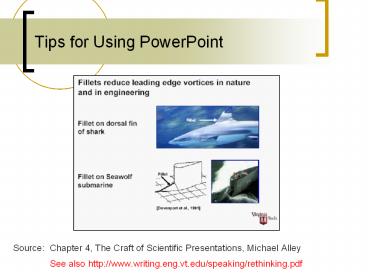Tips for Using PowerPoint PowerPoint PPT Presentation
Title: Tips for Using PowerPoint
1
Tips for Using PowerPoint
- Source Chapter 4, The Craft of Scientific
Presentations, Michael Alley - See also http//www.writing.eng.vt.edu/speaking/r
ethinking.pdf
2
Tips for Using PowerPoint
Goals of a presentation slide
To help your audience understand your main
messages
To serve as notes for the audience after your talk
To serve as a reminder to you of your main point
- Source Chapter 4, The Craft of Scientific
Presentations, Michael Alley - See also http//www.writing.eng.vt.edu/speaking/r
ethinking.pdf
3
Two common problems of slides
Slides that no one can read
- Source Chapter 4, The Craft of Scientific
Presentations, Michael Alley - See also http//www.writing.eng.vt.edu/speaking/r
ethinking.pdf
4
Use readable text format
- Source Chapter 4, The Craft of Scientific
Presentations, Michael Alley - See also http//www.writing.eng.vt.edu/speaking/r
ethinking.pdf
5
Use readable text and layout
- Source Chapter 4, The Craft of Scientific
Presentations, Michael Alley - See also http//www.writing.eng.vt.edu/speaking/r
ethinking.pdf
6
Instead of the PowerPoint default layout,
consider the following structure
Sentence headline
Supporting text in body of slide
- Source Chapter 4, The Craft of Scientific
Presentations, Michael Alley - See also http//www.writing.eng.vt.edu/speaking/r
ethinking.pdf
7
Three criteria for evaluating layout design
How memorable is the design?
How many slides does the design require?
Does the design help the slides serve as notes?
- Source Chapter 4, The Craft of Scientific
Presentations, Michael Alley - See also http//www.writing.eng.vt.edu/speaking/r
ethinking.pdf
8
Use sentence headline to make main assertion
A good headline
Identifies the slides purpose for the audience
Identifies the slides purpose for the speaker
- Source Chapter 4, The Craft of Scientific
Presentations, Michael Alley - See also http//www.writing.eng.vt.edu/speaking/r
ethinking.pdf
9
A bad example
- Source Chapter 4, The Craft of Scientific
Presentations, Michael Alley - See also http//www.writing.eng.vt.edu/speaking/r
ethinking.pdf
10
A better example
- Source Chapter 4, The Craft of Scientific
Presentations, Michael Alley - See also http//www.writing.eng.vt.edu/speaking/r
ethinking.pdf
11
The body of slide should support headline with
images and brief supporting text
Support primarily with images
Support with essential text
- Source Chapter 4, The Craft of Scientific
Presentations, Michael Alley - See also http//www.writing.eng.vt.edu/speaking/r
ethinking.pdf
12
A good example
- Source Chapter 4, The Craft of Scientific
Presentations, Michael Alley - See also http//www.writing.eng.vt.edu/speaking/r
ethinking.pdf
13
Dont provide too much description!
- Source Chapter 4, The Craft of Scientific
Presentations, Michael Alley - See also http//www.writing.eng.vt.edu/speaking/r
ethinking.pdf
14
Dont provide too much detail!
- Source Chapter 4, The Craft of Scientific
Presentations, Michael Alley - See also http//www.writing.eng.vt.edu/speaking/r
ethinking.pdf
15
Have an open and organized layout!
- Source Chapter 4, The Craft of Scientific
Presentations, Michael Alley - See also http//www.writing.eng.vt.edu/speaking/r
ethinking.pdf
16
Make your slides memorable
- Source Chapter 4, The Craft of Scientific
Presentations, Michael Alley - See also http//www.writing.eng.vt.edu/speaking/r
ethinking.pdf
17
Slides should include key results and images
- Source Chapter 4, The Craft of Scientific
Presentations, Michael Alley - See also http//www.writing.eng.vt.edu/speaking/r
ethinking.pdf
18
A bad example
- Source Chapter 4, The Craft of Scientific
Presentations, Michael Alley - See also http//www.writing.eng.vt.edu/speaking/r
ethinking.pdf
19
A better example
- Source Chapter 4, The Craft of Scientific
Presentations, Michael Alley - See also http//www.writing.eng.vt.edu/speaking/r
ethinking.pdf
20
Another good example
- Source Chapter 4, The Craft of Scientific
Presentations, Michael Alley - See also http//www.writing.eng.vt.edu/speaking/r
ethinking.pdf
21
Still another good example
- Source Chapter 4, The Craft of Scientific
Presentations, Michael Alley - See also http//www.writing.eng.vt.edu/speaking/r
ethinking.pdf
22
The importance of figures
Graphic excellence is that which gives to the
viewer the greatest number of ideas in the
shortest time with the least ink in the smallest
place - Edward R. Tufte -
Figures play a significant role in the
expression of scientific ideas - APS Style
Guide -
More on this next week

